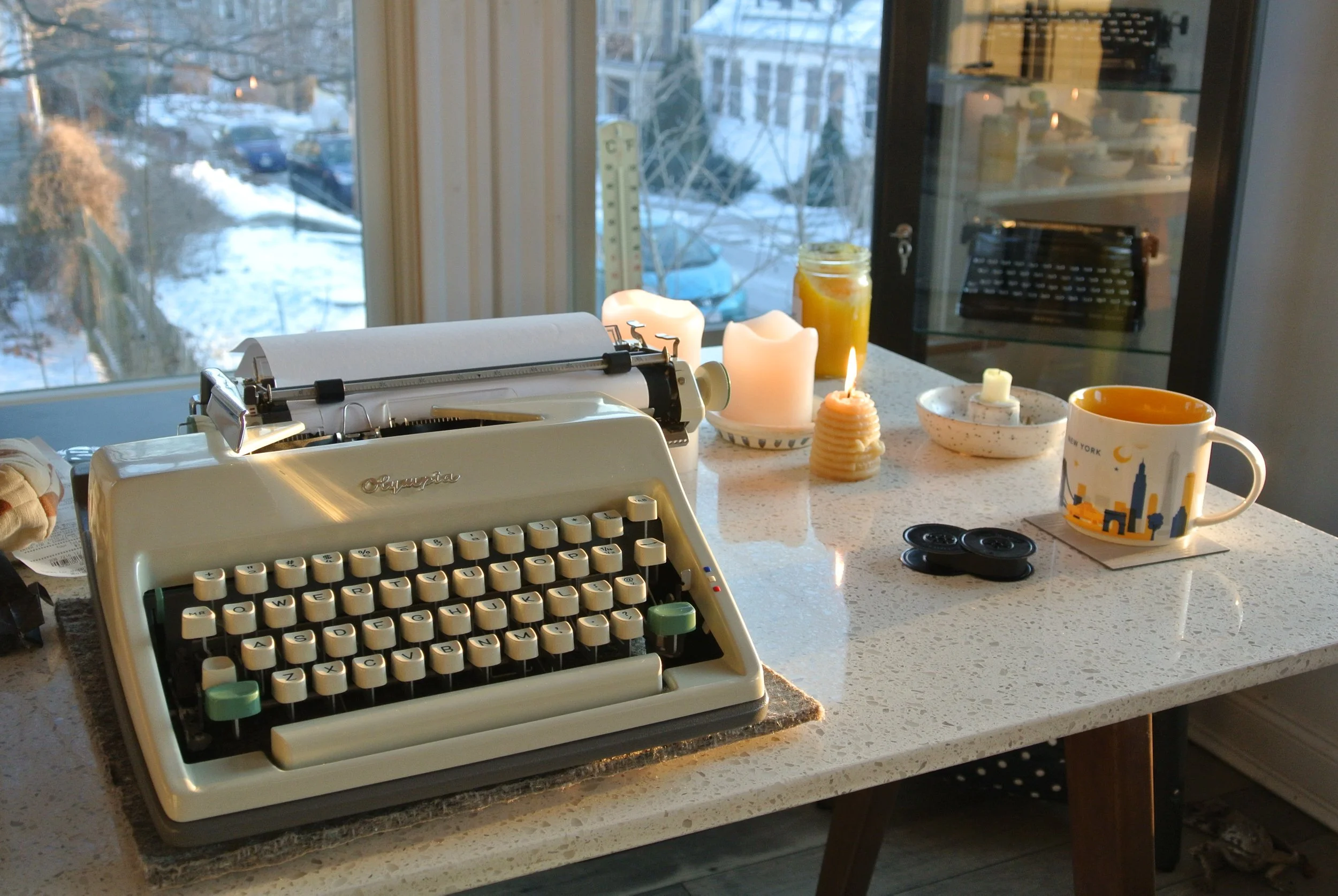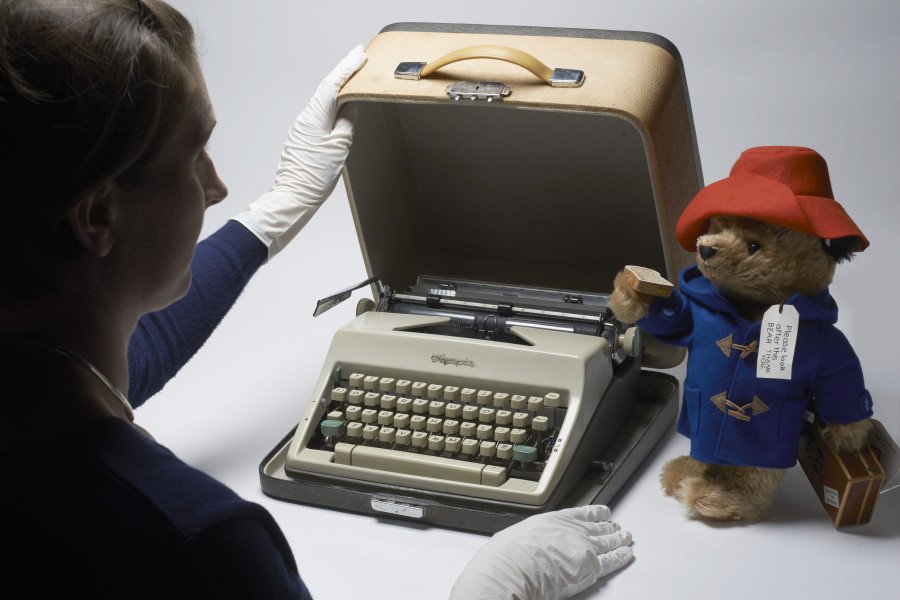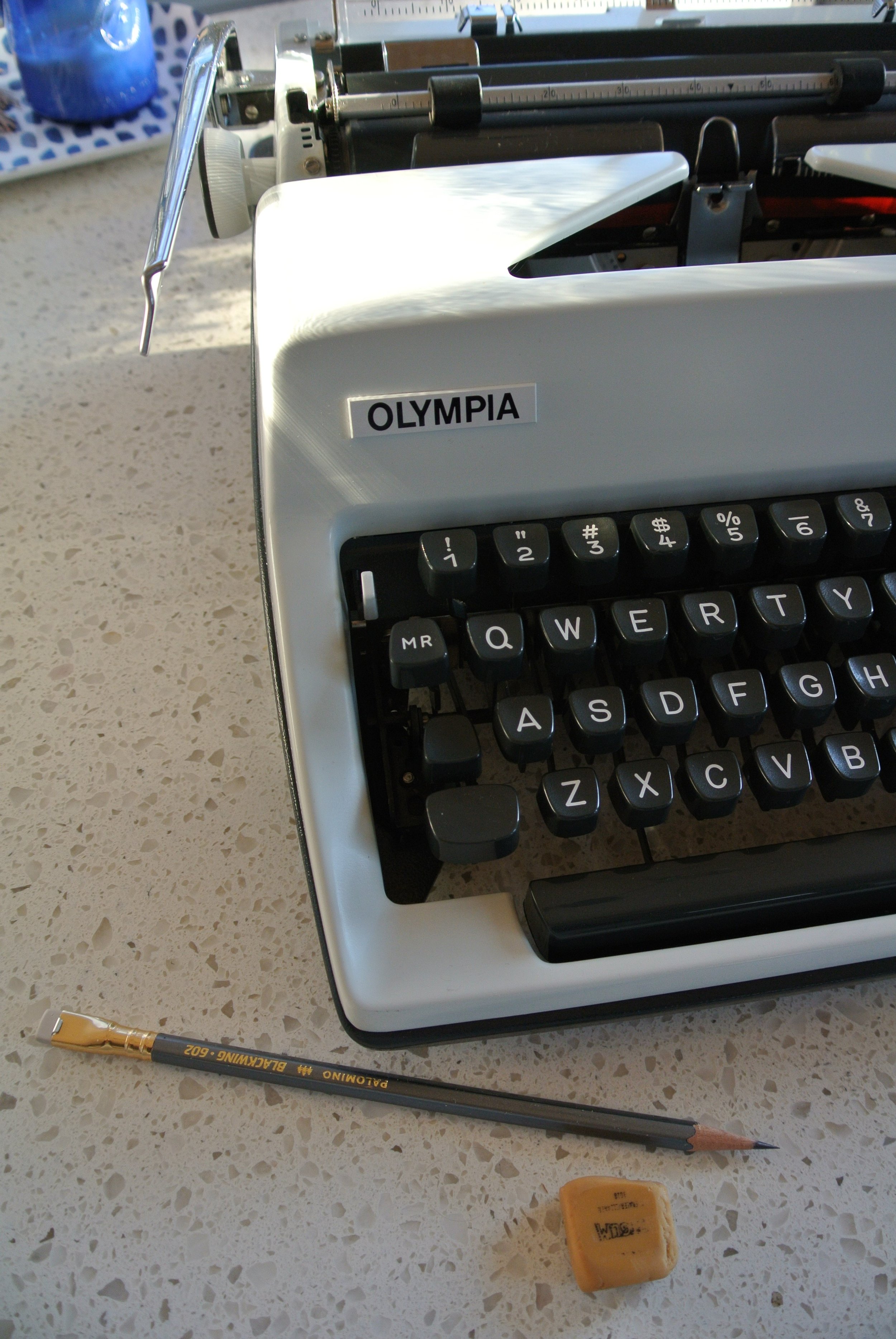When Michael Bond, author of the Paddington and Olga da Polga stories, died in 2017, his venerable Olympia SM9 typewriter was boxed up behind perspex and put on museum display.
The original typewriter that Michael Bond used to write “Paddington at Work” and “Paddington Goes to Town” once he left the BBC in 1965 to work on Paddington full-time.
Understandable but also an anathema. When I see this practical machine, I see a workhorse that wants to be used. It is a word machine, an efficient piece of perfection; German engineering all for one purpose.
You will be hard put to find a better portable typewriter for long, very long pieces of writing.
The Big Move to Basket Shift
Earlier Olympias shifted to capitals by raising the whole carriage, which is not surprisingly known as carriage shift. This is a weighty task, especially during a long writing session. My 1950s SM3 is my anti-osteoporosis weight-bearing workout.
Basket shift is probably better if you’re writing longer. Instead of raising the entire weight of the carriage, the ‘basket’ of type slugs is lowered, a more lightweight task for the typist.
Olympia was late to the basket shift game. Smith Corona had their eloquently named ‘Floating Shift’ perfected by the late 1930s. Why did Olympia stick to the weighty way for so long?
It was 1964 when Olympia took the plunge and introduced both their SM8 and SM9 portable models with basket shift. It makes all the difference. You barely know you’re typing, there is so little interference between thought and paper.
What’s the difference between the Olympia SM8 and SM9?
Yes, it is easy to confuse them.
They are essentially the same typewriter mechanically, except for two small differences, one of which is especially simple: the SM9 has a touch control lever on the frame to the left of the keys. (This controls the feedback or feel of hitting each letter. The higher the setting, the more tension in the swing of the typebar.)
The SM8 does not have this feature so that part of the frame will be blank.
Olympia SM9 Plus/minus on the left denotes touch control selector. Keys to set tabs on either side of the space bar are another SM9 feature. Early model coloring: turquoise shift keys and platen knobs. Notice: a German QUERTZ keyboard and special accent keys. Photo: Carl Ha, CC BY-SA 4.0
The other mechanical difference is how the tabs are set. But basically, if you can see the touch control lever on the left, it is an SM9.
In appearance, the SM8 and SM9 early models had the same light cream color frame with characteristic Olympia-turquoise accents—shift keys, platen knobs, etc. The main keys are cream and the lower half of the frame is a light grey. It is a pleasant, muted color scheme.
Olympia
Early color scheme used in the SM8 and SM9
Olympia
Late color scheme used in the SM8 and SM9
In 1969, Olympia changed both models to a new pared-down look. Deep charcoal grey replaced the turquoise accents and a brighter white frame the muted cream. The silver script squiggle of the Olympia logo that hadn’t changed through all its iterations now became a stylized orange circle on one side and ‘Olympia’ written in all caps on the other. The keys were now all dark charcoal/black.
The later color scheme does not denote a later model number, which is what I thought before writing this post.
The earlier version of either is typically more sought after but don’t pass up a later one for all that.
Two Smokey Tales
Early Olympia SM8
Olympia SM8 with Elite typeface, 12 characters per inch [click to see full size]
Elite refers to the type size: 12 characters per inch or cpi.
By comparison, Pica is 10 cpi, a larger type size.
I found this SM8 with elite typeface on Facebook Marketplace for, I think $75.00, in the Boston area a few years ago. I was dropping off a daughter at college after a weekend visit so, from her college in Worcester, I drove straight down the Mass Pike, and instead of home, shot through downtown and out the other side, over the Tobin Bridge and to the gritty neighborhood of Chelsea.
I made the appointment in time at the seller’s house. The typewriter was waiting, case upside down, just inside the front door. You never quite know what you’re getting into with such a sale, but I’ve never had a bad experience. The seller’s gravelly Boston accent and deep smoker’s voice were like popping up in a extras’ tent for The Town. She said it was hers in high school but had no idea how it worked. It looked at me like a puppy in the pound, pleading to come home and be cleaned up, so home it came, trailing a fug of smoke fumes.
I liked that it came with a handmade cloth cover in my favorite shade of golden yellow which I hoped would make a helpful pattern for sewing other covers.
There was nothing functionally wrong with the SM8 so I decided to clean it up myself rather than drop it off at Cambridge Typewriter where I typically get repairs done.
With an audiobook of Agatha Christie’s first novel, The Mysterious Affair at Styles playing over several evenings, I quietly cleaned type-slugs and the biro someone had scribbled inside the logo, the surface crud of smoke layers, and all the inner workings, all while thinking of people’s lungs, and strychnine poisoning (thanks, Agatha)!
This was shortly before the pandemic when life was swinging along at quite a furious pace and that machine slowed me down in a good way. In fact, I’ve since listened to nearly all of Christie’s novels. I’m nearing the end of them; the pandemic has been one long mystery.
To remember this machine’s origins, I keep a box of candy cigarettes tucked in its ‘basket shift’ basket.
The much-loved SM8 lives either out on the printer table by my art studio desk, a swivel away from use. Or when I need the end of the printer table for a project, the typewriter goes back in its functional grey and cream case propped nearby.
Summer morning desk with Olympia SM8 (and typewriter cat).
The machine donated its (cleaned) golden cover to the Olympia SM3 which lives on a desk in our finished basement—a virtually soundproof space, thankfully, for late-night typing sessions that might otherwise disturb everyone’s sleep. I have yet to make more covers.
One day I took the SM8 in to show Tom Furrier at Cambridge Typewriter and see if he had a rubber cushion for under the spacebar since one was missing. He popped one on and wondered if it was for sale. No, this is a keeper of keepers.
I asked Tom if he could keep an eye out for an Olympia with a cursive typeface. But as it happened, within a few weeks, I had found one myself.
Like pets, typewriters have a way of finding themselves a new home.
Cursive Typeface Olympia SM9-which-is-actually-an-SM8
As you can see this is the charcoal and white later version of the Olympia SM8. Until I wrote this post, I really thought this was an SM9 because of the later design. But no. It doesn’t have touch control. Always something to learn with typewriters!
This one was also a local pickup found on Facebook Marketplace, my favorite way to find typewriters. And it was also about $75.00 and could be cleaned up at home.
But this one came with a story.
I was delighted to learn this typewriter had been in the office of a letterpress printing company near Harvard in Brattle Square, Cambridge. The company had been founded by the seller’s grandfather. Her husband, father, mother, and uncle all worked together there and the typewriter belonged to the seller’s 90-year-old mother, newly in a nursing home.
Late SM8 with black vinyl case and molded plastic interior.
There had once been a fire at the Press, the seller reminisced. The fire had so damaged the building that nothing was left but the structural girders with the upstairs linotype machines suspended on them. They had to hire a crane to get the linotype machines down! The business was rebuilt and this lovely Olympia machine lived in the office in the 1970s and beyond.
It was flawless, and all the richer for hearing its story.
This typewriter lives in its pristine black vinyl case with molded plastic interior most of the time, at the side of my desk, ready to whip out cursive chatter in red or black at a moment’s notice—letters, postcards, and notes mostly.
Visting children also enjoy the fun of being able to type in instantly neat handwriting!
TYPEFACES
Olympia machines come in a great array of typeface sizes and styles and with keyboards for different languages and world markets. I have seen them for academics in Middle English, in Hebrew and Arabic, Scandinavian and Eastern European languages, and even for specific medical or mathematical purposes.
FAQs
“How do you know if a machine is cursive?”
Ask. Though that might put the price up. If there’s no type sample in the sale photos, notice, does the typewriter have a ‘1’ key?
Curly cursive typeslugs [click to see full screen]
Lowercase letter ‘L’ doubles as the number one on many machines to save keys. This won’t work when a machine is cursive because the curly cursive letter ‘L’ does not work as a number. A dedicated number 1 key is needed. If a typewriter has a ‘1’ key, it’s not definitely a cursive typewriter, but it is something to notice.
My cursive Olympia was specifically advertised as such which made the drive to Boston’s South Shore more of a sure thing. But it’s not uncommon when you buy a machine to find you have a lovely typeface surprise.
“How old is my Olympia machine?”
Find the serial number. On an SM8 or 9, carefully tilt the machine up (with the paper support stowed) and you will find its unique serial number stamped on the frame underneath, by the right, back foot.
[click any to see full screen]
Serial # on an early SM8 design. Note the rectangular feet. From the Typewriter Database, this is a 1967 machine.
Serial # location on a late Olympia SM8. And round feet! A 1972 machine.
Head over to the Typewriter Database. On this page for all Olympias, scroll down to your model and find the year which includes your machine’s serial number.
You can also compare machines by model at these pages, listed by year and serial number by their owners, with plenty of photos:
It’s interesting to compare the different typeface samples and for keyboards in different languages.
(Want to go down a rabbit hole and see the earlier SM models? You’ll find them here: SM1, SM2, SM3, SM4, SM5, SM7, and the Olympia Monica, whose late version is also similar to the SM8 and 9 but is helpfully labeled, ‘Monica’. Why didn’t Olympia label any of its other mid-sized portables?!)
“Where do I find a User Manual and new Ribbon?”
You can download the relevant user manual at these links. Thanks to the repairman at Classic Vintage Typewriters and to Richard Polt for these. Instructions on how to install a new ribbon are in the manual.
The correct ribbons to fit your Olympia are available from Amazon.
(If you purchase a ribbon at this link, a tiny portion of the sale supports the costs of this website.)
Ribbons are available from many typewriter resellers such as Charlie Foxtrot Vintage in the UK as well as on Etsy.
For interesting colors, I like to get ribbons from The Modern Typewriter store on Etsy which sells ribbons in about 19 color combinations.
You can buy a two-color ribbon, or install a solid color ribbon and get twice the life out of it, top and bottom, by changing the ribbon selector setting on your Olympia. A ribbon typically lasts 4 months to a year+ of use, depending on how often you type and how quickly it dries out.
Famous Authors and Their Olympia SM8 and SM9s
Either SM8 or 9, both were a great choice for a writer. Thanks to Richard Polt for these links. Spot the cigarette … and pipe.
“I am always at my desk by 9am. I use a laptop, which is usually buried under papers, and I have a typewriter, too. I like typewriters; you can type with real flourish. ”
Thanks for Reading
The Olympia SM8 joins in a pre-pandemic letter writing night for neighbors and friends!
To read more about letter writing nights and other ways to use a typewriter:
For more help:
How to Clean and Oil a Typewriter (Typewriters 101 website)
Basic Typewriter Restoration (Richard Polt’s The Classic Typewriter Page)
I’d love to hear from you in the comments. And subscribe in the footer below for more episodes of Typewriter Diaries.







